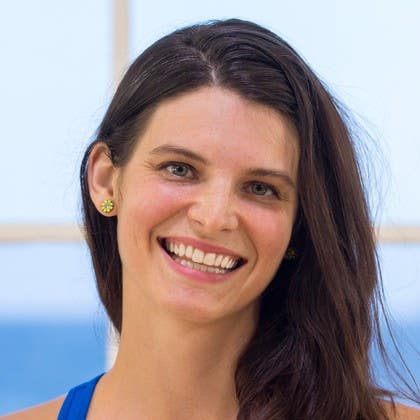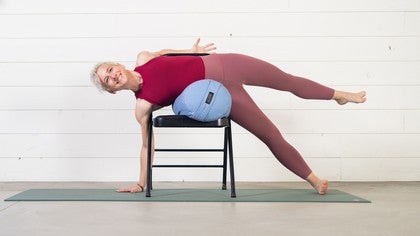
Yoga for People Who (Think They) Hate Yoga
I hated rock climbing when I lived in Boulder. It’s a rock climbing capital; it’s practically the city’s official sport. You couldn’t have paid me to rock climb back then. It was obnoxious to me, an activity for dudebros in fleece Patagonia vests and white kids with dreadlocks, who worshipped sheer rock faces and IPAs. I hated it.
Nearly 17 years later, stuck in my apartment after ten months of COVID and scrolling through Instagram, I paused on a video of a person I follow climbing at a gym. When yoga comes in handy, she captioned it. In the clip, she was negotiating the wall using her leg, hoisting herself by extending one limb out, pausing, contemplating weight, and suddenly lifting in a big pull. Huh, I thought. That looks fun.
Now I think about rock climbing, I wonder if I didn’t like it because I didn’t understand how I could make it mine. I didn’t have the correct context. Framed in a lens I understood - yoga - rock climbing suddenly seemed alright. There are times now when I look at yoga from outside my biased perspective and think, Okay yeah, I get why someone wouldn’t want to do this. It can be cliquey, culty, and incredibly commodified. Finding context can be a tricky business.
Boulder is where my relationship with yoga deepened. I took my first teacher training there, taught my first classes there. Where I began with yoga - reluctant, skeptical, curious - isn’t far off from where I am now. My sister was convinced it would help me, and annoyingly, she was right. It did help me. It still helps me. But in between, a lot of Downward Dogs, intense eye-rolling, and earnest change.
Missioner and Malcontent
One of my favorite art pieces is a scribbled hand drawing of a distressed stick figure fleeing, her little stick hands by her ears in defiance. A speech bubble chases her, the words inside read: Have you tried yoga? It’s by The New Yorker illustrator and artist Liana Fink, and in the world of the drawing, I am both the stick figure and the speech bubble. Evangelist and apostate, missioner and malcontent.
Yoga works for me. It introduced me to concepts of self-care and confidence, ushered me into an ever-expanding world of wellness, which I have learned to define as personal and unique to me. Yoga solves problems in my body and empowers me to grow as a person. I would love for everyone to experience what I have through yoga. And so, like my sister before me and the speech bubble in the cartoon, I have stood on my soapbox and evangelized about the wonders of Downward Dog and deep breaths. I also, at times, genuinely hate it.
There’s wellness, and then there’s the wellness world.
I often joke that I hate yoga. But that’s not true. What I hate is capitalism. I hate the Wellness Industrial Complex and the thin, white-washed image of yoga in mainstream marketing and media. If I thought yoga was what I saw on my social feeds, I would assume I needed matching earth tone leggings, consistently toned triceps, and a production team to film advanced sequences set to lo-fi beats or acoustic covers of hip-hop songs. Scrolling through my Instagram feed of mostly yoga and wellness world folks, my eyes often feel stuck at the back of my head (even at my posts), and cringe at the inevitable #outfitby and #musiccredits at the end of the posts, the tagged brands, and the filtered light. But that’s not yoga. That’s marketing.
What you see on social media often isn’t real, but it’s as accurate as you want it to be. Frankly, I’ve made my peace with the marketing. It’s not going to go away. But it doesn’t have to be true all the time. To practice yoga, you don’t need to buy anything or wear a particular brand or drink a specific kind of smoothie to seek health. Find a practice you like, and practice with what you have: Your body and your breath. Do it in new spandex or last year’s Christmas pajamas. Do advanced physical postures if they make you feel good. Yoga happens in your body and your spirit, not on your Instagram feed.
Opposites attract
Like Frodo and the ring, yoga and the broader world of wellness is something I love and hate. But that’s not such a bad thing. After all, yoga is the work of opposites: strength and flexibility, inhale and exhale, Yin and Yang, commodification and decommodification, self and the idea of self. The magic and work of this practice are in balancing those opposites, not being ruled by one over the other. I spend less time engaging with social media and standing on my soapbox, and spending more time living my yoga.
Yoga isn’t all peace and love. It’s about righteousness.
Most yoga has a direct lineage to its roots in India. What you see on social media and in popular classes often comes with a serious side of spiritual bypassing and glosses over yoga’s rich and diverse history. There’s so much more to it than stretch pants, peace, and love. Yoga is a practice centered in honesty, in learning how to respond to life with righteousness, compassion, and clarity, even if it means being uncomfortable. In the Bhagavad Gita, one of Krishna’s central motives is to do the right thing, not the "peaceful" thing. If you roll your eyes at hashtags like love and light, grab a copy or find a class, and dig in. It’s a wild ride.
But you don’t have to be spiritual to practice yoga. That’s something I love about it: yoga gives you the tools to make philosophy come to life in a way that works for you and your life. Yoga’s myths, legends, and history offer an incredible backdrop that will broaden your perspective and enrich your thinking. The wonderful thing about yoga and the human mind is that both are big enough to hold many ideas. Yoga is a skill in action: listening, responding, connecting. These lessons can translate to direct action on climate change, social justice, and the millions of daily choices we make in our lives.
You don’t need to be flexible.
Seriously. There’s no body type that’s better or worse for yoga. I’d argue yoga is more valuable if you’re not young and flexible. Standing splits? I don’t know her. Over the years I’ve been practicing yoga, my body has changed and changed again. In the same way that bypassing the roots of yoga is a disservice to the richness of the practice, so is thinking of it as "stretching". Physically speaking, asana is a method of building power and suppleness in your body. It is dynamic, therapeutic, and certainly not one-size-fits-all. I took almost every *kind* of yoga asana until I found a style that made sense to me. Even this has changed.
Define it for yourself.
It’s okay if you don’t like it. If I have learned anything from yoga, it’s that liking something is not required to benefit from it (I’m looking at you, Ustrasana). It will still be good for your hamstrings or shoulders or quality of breath. It’s also okay if you hate it. Nothing you do now is something you have to do forever.
Try something and if you don’t like it, change. But explore ways of creating your own context for yoga. Maybe it’s the predictable comforts and structure of Ashtanga or the outsized joy of a Vinyasa class set to the music of Carly Rae Jepson. Perhaps you love traditional Hatha, with props and alignment, or Kirtan. Your yoga doesn’t have to look like mine, and it certainly doesn’t need to look like what you see in classes or on social media.
For me, the value of yoga has been finding the freedom to change - my experience in my body, my thoughts, and yes, my crotchety attitude. It has even shifted my perspective on rock climbing! Find a way to move in your body that makes you feel alive, that makes you feel present. And stretch your hamstrings now and then.
Comments

You need to be a subscriber to post a comment.
Please Log In or Create an Account to start your free trial.








